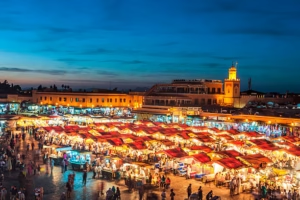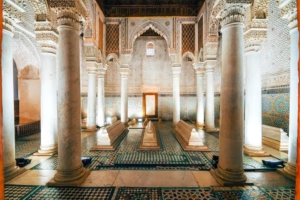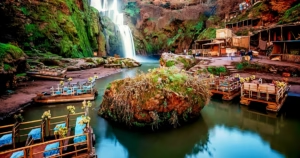Marrakech, often called the “Red City” for its striking red sandstone buildings, is a place where history, culture, and modern energy blend seamlessly. Nestled at the foothills of the majestic Atlas Mountains, this enchanting city invites travelers to step into a world of bustling souks, mesmerizing palaces, and a vibrant way of life.
As Africa’s most visited city, Marrakech captivates millions of tourists each year with its dynamic mix of Arab, Berber, and European influences. Whether you’re wandering through its labyrinthine medina, sipping mint tea in a tranquil riad, or bargaining for treasures in the souks, Marrakech promises an experience like no other.
Marrakech’s charm lies in its ability to offer something for everyone—history lovers, adventurers, foodies, and those simply looking to soak in its unique atmosphere. Here’s what makes it so special:
- Rich History: Founded in 1062, Marrakech has been a center of trade, culture, and power for centuries.
- Vibrant Culture: The city bursts with traditional music, colorful festivals, and warm hospitality.
- Architectural Marvels: Stunning palaces, intricate mosques, and breathtaking gardens adorn the city.
- Accessibility: Well-connected by air, with direct flights from major cities worldwide.
Jemaa el-Fnaa Square

The heart and soul of Marrakech, this UNESCO-listed square is a spectacle of life. By day, it buzzes with snake charmers, juice vendors, and henna artists. By night, it transforms into a festival of food stalls, storytellers, and musicians, offering a sensory overload you won’t forget.
Koutoubia Mosque
A symbol of Marrakech, the Koutoubia Mosque stands tall with its exquisite 12th-century architecture. While non-Muslims cannot enter, its exterior and serene gardens provide a glimpse into its grandeur.
Bahia Palace
Step into the opulence of 19th-century Moroccan royalty at Bahia Palace. With its intricate tilework, grand courtyards, and lush gardens, it’s a testament to the country’s rich artistic heritage.
Majorelle Garden
A peaceful oasis in the city, Majorelle Garden was designed by French painter Jacques Majorelle and later restored by Yves Saint Laurent. Its deep blue accents, exotic flora, and tranquil paths make it a must-visit.
Saadian Tombs

Hidden for centuries and rediscovered in 1917, these tombs date back to the Saadian dynasty of the 16th century. Their delicate carvings and quiet beauty transport visitors to a bygone era.
Traditional Souks
Lose yourself in the maze-like souks of Marrakech, where vibrant stalls sell everything from handwoven carpets to aromatic spices. Bargaining is an art here, so embrace the experience!
Moroccan Cuisine
Indulge in the flavors of Morocco with dishes like savory tagine, fluffy couscous, and sweet pastilla. Want to take a piece of Marrakech home? Join a cooking class and master the art of Moroccan cuisine.
Hammams and Spas
Relax in a traditional hammam, where a steam bath, exfoliating scrub, and soothing massage will leave you feeling rejuvenated. Many riads also offer luxury spa treatments for an elevated experience.
Atlas Mountains
A short drive from the city, the Atlas Mountains offer breathtaking landscapes, charming Berber villages, and incredible hiking opportunities.
Ouzoud Waterfalls

One of Morocco’s most stunning natural wonders, these cascading falls offer the perfect escape. Take a boat ride to the base or enjoy a scenic hike.
Essaouira
For a change of pace, visit the coastal town of Essaouira. Known for its relaxed vibe, historic medina, and delicious seafood, it’s an ideal getaway from Marrakech’s energy.
Best Time to Visit
The best seasons to explore Marrakech are spring (March- May) and autumn (September–November) when the weather is pleasantly mild.
How to Get Around
- Walking: The best way to explore the medina is on foot.
- Taxis: Use petit taxis for short distances and negotiate the fare in advance.
- Car Rentals: Ideal for day trips but unnecessary within the city.
Safety Tips
- Dress modestly to respect local customs.
- Stay alert in crowded areas to avoid pickpockets.
- Avoid walking alone at night in unfamiliar places.
Q: Is Marrakech safe for tourists?
A: Yes, it’s generally safe, but like any major city, staying vigilant is wise.
Q: What currency is used in Marrakech?
A: The Moroccan Dirham (MAD) is the official currency.
Q: Do I need a visa to visit Marrakech?
A: Visa requirements vary by nationality. Check with your nearest Moroccan embassy.
Q: What language is spoken in Marrakech?
A: Arabic and Berber are the official languages, but French is widely spoken. English is commonly understood in tourist areas.
Q: Can I drink tap water in Marrakech?
A: It’s best to stick to bottled water to avoid any stomach issues.
Marrakech is a city that effortlessly blends the old with the new, the chaotic with the serene. Whether you’re exploring the ancient medina, sipping mint tea on a rooftop, or embarking on a desert adventure, the Red City leaves an imprint on your soul.
As Africa’s most visited destination, Marrakech continues to enchant travelers with its timeless charm and vibrant culture. Pack your bags and prepare for an unforgettable journey!
- Official Morocco Tourism Website
- Lonely Planet Guide to Marrakech
- UNESCO World Heritage Sites in Morocco



